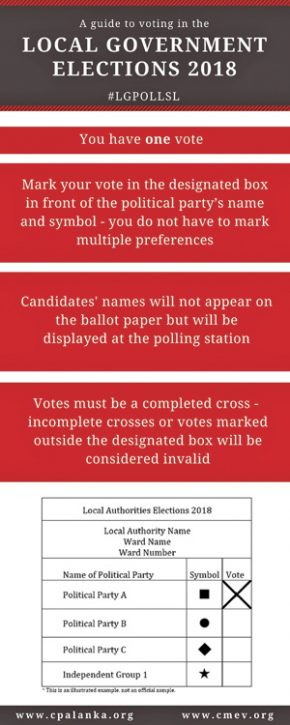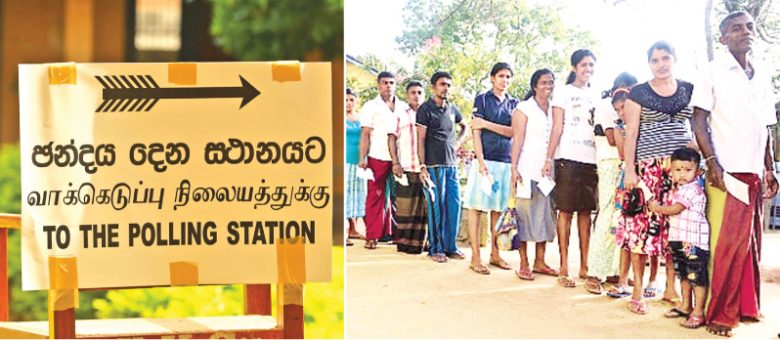Handing out leaflets, knocking on doors, holding meetings and driving around in vans fitted with loudspeakers, announcing to the world why they alone need your vote. These have become a common sight as the local government elections get closer.
With the introduction of new electoral system for the polls, voters are confused with regard to how the system would work. The new mixed electoral system consisting of the proportional representation system and the first-past-the-post system has many ask the question of how this would translate onto a ballot paper.
New electoral system
The local government authority (LGA) is the most important institution which can cater to local needs according to the tastes of its people and thus it is an important start to any politician’s career and thus February 10 will be a hard fought battle for all.

Ministry of Local Government and Provincial Councils’ Legal Officer Gayani Premathilake said the new system would help voters appoint someone from their own ward and thus make government more familiar to the people.
She further said the new system would, to a great extent, ensure a corruption-free local government system.
At the time of gaining Independence in 1948, there were four types off local government institutions as municipal councils, urban councils, town councils and village councils and these were governed by a system known as the first-past-the-post system.
A preferential voting system with a proportional representation system was introduced by the 1978 Constitution. Thereafter, the 13th Amendment to the Constitution was introduced to grant more powers to local bodies – this done under Indian influence was seen as a solution to the ethnic problem in the country. The constitutional change introduced the provincial council system.
As of November 2017, there are 341 local authorities (24 municipal councils, 41 urban councils, 276 divisional councils).
Law related to new system

The new election system was introduced by Local Government Authorities Elections (Amendment) Act No. 16 of 2017 and the total number of members of local authority at ward level was determined by the National Delimitation Commission (NDC).
It is expected to be the largest election in Sri Lankan history and will be the first time elections to all local authorities are held on the same day. These will also be the first elections under the mixed electoral system, whereby 60 percent of members represent single-member or multi-member wards and 40 percent are returned from a list called ‘additional persons’ list’ without a ward-based continuance.
Two nomination papers have been submitted, one comprises the number of candidates equivalent to 60 percent of the total number of members of LGA and the other comprises the number of persons as equivalent to 40 percent of the total number of members of the local authority plus three additional names.
Candidates under the first nomination paper will contest and are entitled to be elected as members of local authority and persons under the second nomination paper are entitled to return as members of that LGA based on the number of seats their party wins.
In the meantime, the total number of members in local government has been increased from 4,486 to around 8,356 members. According to Section 27F of the Amendment, 25 percent of the total number of members in each local authority have to be women. Note that this does not mean that 25 percent of the elected members of every party must be women. This is an overall percentage for the LG body.
When contesting, the Local Authorities Elections (Amendment) Act passed on August 25, 2017, decreed that 10 percent of the members assigned to a ward be women and 50 percent of members on the additional persons list be women. The 50 percent on the additional list will only enter the LG body depending on the number of votes their respective party wins.
Counting votes
The voter, this time around, only needs to cast a single vote for his or her party of choice at the ward level. He or she will not be required to choose a candidate of choice.
At the conclusion of the elections, the Elections Commission will, through a complex system, determine how many seats each party should be allocated based on the votes cast.
Therefore, the Commissioner must first determine the number of votes required for entitlement of a member. This is computed by dividing the total number of votes received by all parties and independent groups by the prescribed number of members of each local authority (this number is gazetted). The total number of votes received by each political party or independent group is then divided by the number of votes required for entitlement of a member to ascertain the number of members elected by each party.
Explaining the division of number of members among political parties and independent groups, Premathilake said that the votes received by all political and independent groups (prescribed number of members for that LGA) is required to be entitled as a member of the Local Government Authority.
She further explained that the number of members that could be entitled would depend on the number of votes received by each party within that LGA.
“In case a party has secured more wards than the number of members they are entitled to, there are provisions to elect those candidates also as members of that LGA. Law introduced to this situation is known as an overhang. And if the party has secured less wards than the number of members they are entitled to, those number of members (shortfalls) can be returned by the respective secretary of the recognized political party,” she said.
Women’s representation
The Commissioner of Elections is required to ensure 25 percent women’s representation in terms of Section 27F and Sub Sections 3 and 4 of Section 65 AA of the act.
According to Head of Media Research at Verite Research, the bill perceived to have addressed two problems of the existing electoral system and they are the twin problems of discipline and diversity.
She said that the problem of discipline was expected to be addressed by reforming the electoral system with a mixed system and the problem of diversity was expected to be addressed by including women’s representation to a minimum of 25 percent.
Premathilake said that the Local Government Act amendment in 2016 ensured 25 percent compulsory women’s representation in LG bodies.
This election in a way has given the voter less of a choice, we cannot choose the candidate for our ward as we simply vote for the party, but it has also made it easier for those with fewer means to contest. Further it has removed intra-party competition, making the process more peaceful and less violent. Despite the laws and systems however, whether an electoral system works or not can only be discerned through experience and its impacts will only be felt as the nation wakes up to a new democracy on February 11.

Taken from Daily News
